
Of all the Great Lakes, Lake Erie is the shallowest and, therefore, the warmest. It also happens to be the smallest in terms of volume and the southernmost in terms of geographical location. Memorable for these qualities, the lake is relatively young as a geologically natural body of water. Glacial ice deepened and expanded its basin thousands of years ago, allowing fresh water to settle and foster a historically vital environment for wildlife.
Several microclimates exist in this great lake, contributing to a complex ecosystem that is sensitive to human activity. Currently, environmental stability tends to fluctuate as a result of considerable nutrient input and the introduction of foreign plant and fish species. Eutrophication, which occurs when the water column becomes markedly enriched, has brought about repeated algal blooms at the detriment of economically important bivalves, crustaceans, and fish.
Despite alarming pollution rates towards the latter decades of the 1900s, Lake Erie has become home to the most abundant populations of fish in the Great Lakes region. It supports a commercial fishery industry that is reputedly one of the world’s largest, significantly boosting the economies of bordering states – Ontario up north, and New York, Pennsylvania, Michigan, and Ohio below the U.S. border. A popular destination for sport fishers from all over the globe, this precious resource is home to about 130 fish species. The most dominant ones are listed below.
Fish Species in Lake Erie
1) Walleye (Sander vitreus)
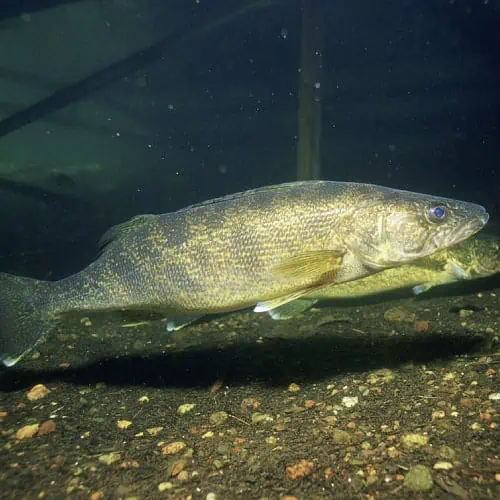
You can count on Lake Erie to produce some of the largest walleyes you’ll ever catch. Specimens that reach a length of 17 – 24 inches (43 – 61 cm), on average, are commonplace in summer. Sport fishers begin searching for them as early as April, which is when they tend to remain closer to the lake’s surface. The best time to try your luck is during a night trip. As this species is quite sensitive to bright light, overcast or choppy days are also a great time to catch them.
Researchers have declared a generous 2018 estimate of about 100 million walleyes in Lake Erie. This is definitely one of the most dominant species, and it can only occur in such large populations due to the high productivity of the lake. As apex predators, walleyes significantly shape the rest of the fish communities in the lake. With a skyrocketing abundance, new spawning grounds are spotted each year, turning the lake into a walleye mecca.
2) Steelhead (Oncorhynchus mykiss)

Steelhead is the common term for migratory rainbow trout. The tributaries of Lake Erie are flush with this angler favorite throughout winter and spring (October – April) while they make their way upstream to spawn. Initially introduced into the lake in the 1880s, Erie’s steelhead fish now attract anglers from all over North America. Many visit annually to experience the exhilarating steelhead run. The energetic fish are said to leap acrobatically out of the water and put up an excellent fight.
Several of Lake Erie’s harbors, including Dunkirk, Barcelona, and Buffalo, are also prime fishing areas for steelhead. Once they move into deeper water, toward the end of fall, they can be targeted close to the thermocline along the mouths of tributaries. Specimens caught in the lake generally weigh an average of 5 – 8 pounds (2.3 – 3.6 kg). At the peak season, even 10 to 12-pound (4.5 – 5 kg) fish become commonplace, so heavier fishing equipment will likely be required.
3) Smallmouth bass (Micropterus dolomieu)
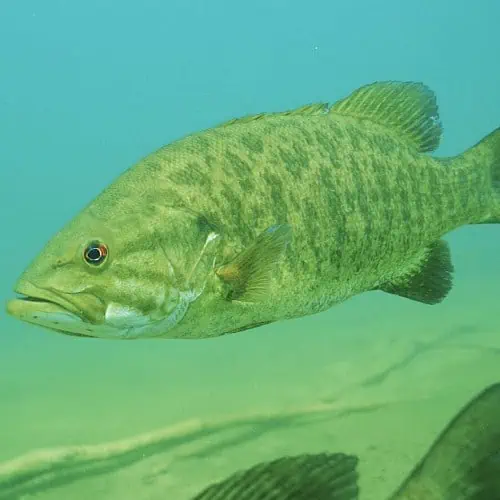
Commonly known as brownie, bareback bass, bronzeback, and smallmouth, M. dolomieu is a staple game fish and one of the most popular of the black basses. This predatory fish grows to a maximum length of 27 inches (68 cm) and can weigh as much as 12 pounds (5 kg). Slender and muscular, it is an undoubtedly powerful swimmer. This species is so frequently caught in Lake Erie, that it has become the principal target fish for approximately 25% of all sportfishing trips each year.
To successfully score some prime smallmouth, anglers should target the harbors, nearshore reefs, and tributaries of the lake each spring. In these areas, they tend to be concentrated in warm pools with abundant minnow populations. They eventually move into the cooler waters of the open lake in summer. At this time, they may remain at a depth of 20 – 40 feet and prefer to stay close to structurally rich bottoms.
4) Yellow perch (Perca flavescens)
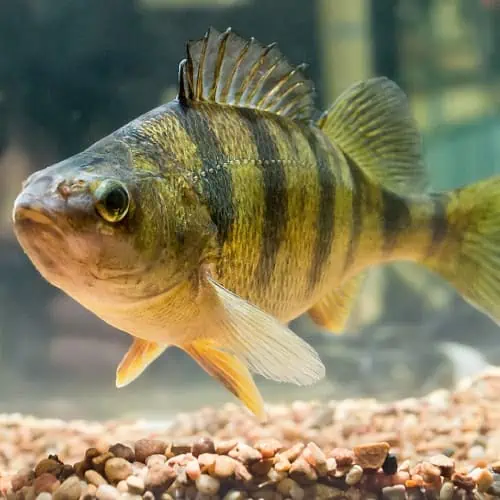
Once common throughout the lake, yellow perch populations have been observed to crash as walleye populations have shot up. Hatchery rates in the past few years have reportedly been poor, making it difficult for mature fish to restore numbers. As a result, daily catchment limits for this species have drastically been reduced, unfortunately angering many local anglers. Optimal environmental conditions are crucial for recovery.
Yellow perch play a median role in the food web of the lake. They consume primary consumers, such as molluscs and crustaceans, and are a choice prey for many larger game fish. They tend to frequent clear water areas, where they may navigate in schools and seek cover from vegetation. Worms, minnows, and larvae are quite an effective bait for hungry perch, which are best targeted when they settle in warmer lake pockets in spring.
5) Northern pike (Esox lucius)
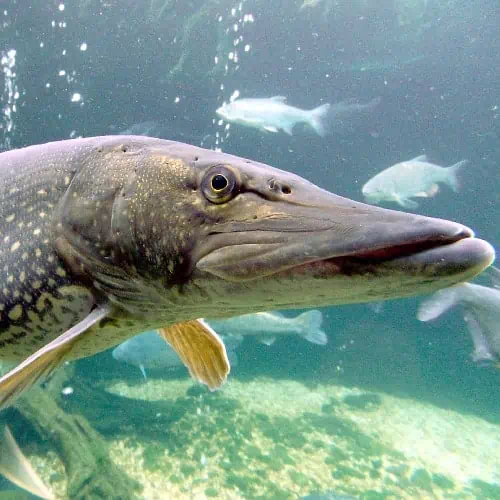
In the Lake Erie complex, northern pike is found in bays along the western basin, in marshlands, and in nearby tributaries. Reputed to be one of the lake’s top predators, it is known for preying on a wide assortment of small fish species, which are quickly immobilized by its sharp teeth. Typically solitary, this species hunts by stalking its prey fish and by darting forward to take a bite when the time is right.
Though considered highly edible by some European communities, pike caught in the US are frequently released by anglers as they may be averse to its bony flesh. Nonetheless, it is a fantastic gamefish to behold, merely for its sheer size and appearance. E. lucius can grow to a maximum length of 59 inches (150 cm) and weigh as much as 63 pounds (28 kg)! Its elongated body is unmistakable and is generally dappled all throughout with brown to yellow-green speckles.
6) Brown trout (Salmo trutta)
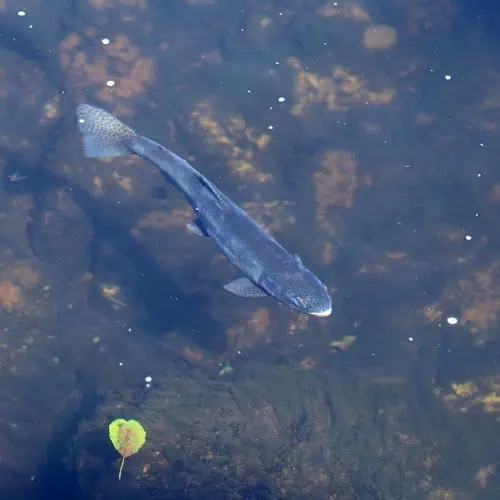
Widely introduced into North American freshwater systems, brown trout is an anadromous species with purely lacustrine ecotypes. Those found in the Great Lakes region are restricted to lakes and rivers, which they migrate into to spawn. Also known as lake trout, this predatory fish helps regulate macroinvertebrate populations. Their decline in some areas has been associated with imbalances in the natural food web.
Favoring highly oxygenated water and temperatures that range between 16 – 18˚C (60 – 64˚F), brown trout “summer kills” occur increasingly frequently due to climate change. To meet global demands for this food and game fish, this species is now artificially propagated and stocked throughout the temperate zones of the US and Europe. A rich source of iodine, omega-3 fatty acids, and proteins, it is considered the most nutritionally desirable among the trout species. It is fortunately distributed throughout Lake Erie – thousands are annually stocked into the Pennsylvania tributaries.
7) Lake whitefish (Coregonus clupeaformis)
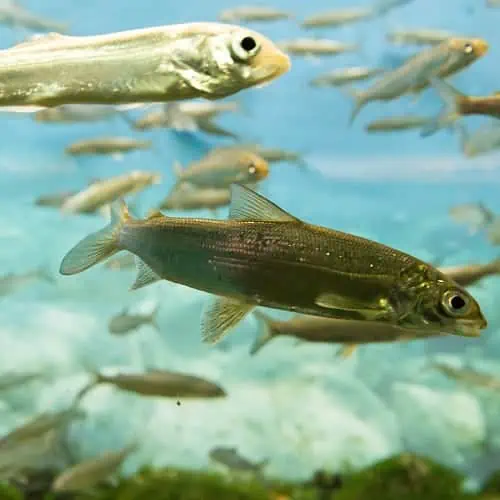
Lake Erie is heavily harvested by commercial fishers for lake whitefish. Most aggregations are captured from the western basin of the lake, close to the mouths of tributaries. As a cool water species, they tend to migrate into deeper sections of the lake in summer, only resurfacing to the shallows in November to December. They must do so to spawn in cold shallow waters, with a depth of about 2 – 4 meters (6.5 – 13 ft). They prefer rubble or gravel as a substrate for their eggs.
You’ll have likely encountered this species in your grocery’s fresh or frozen seafood section. In the US, millions of lake whitefish are consumed each year due to the fish’s meat quality and mild flavor. Anglers also enjoy catching whitefish as they can be hooked with simple ice-fishing techniques. Hooked waxworms, or a basic line and jig combo are quite effective at luring in this species. Do note that it’s a fast swimmer, however, so you’ll have to keep a close eye on the line!
8) Round goby (Neogobius melanostomius)
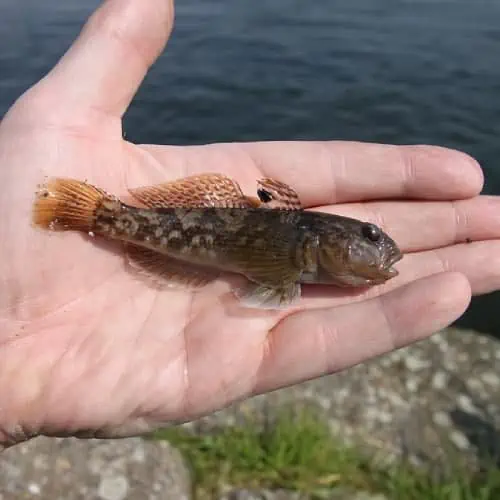
Round gobies were introduced into the Great Lakes system in the 1990s. Since then, their non-native populations have thrived and expanded to occupy most of the system’s tributaries. Now considered invasive, this species has impacted Lake Erie by directly competing with native fish for food. It also consumes several small fish species, causing marked declines in their populations.
Nonetheless, there is one benefit of round goby invasion that must be pointed out. One of its favorite treats is the similarly invasive zebra mussel, which filters out large amounts of phytoplankton from the water column. As zebra mussel populations dwindle as a result of goby consumption, native fish that rely on phytoplankton to be a main source of their diet are able to acquire more food. Both positive and negative impacts on the lake amount to the need for complex management strategies.
9) Lake sturgeon (Acipenser fulvescens)
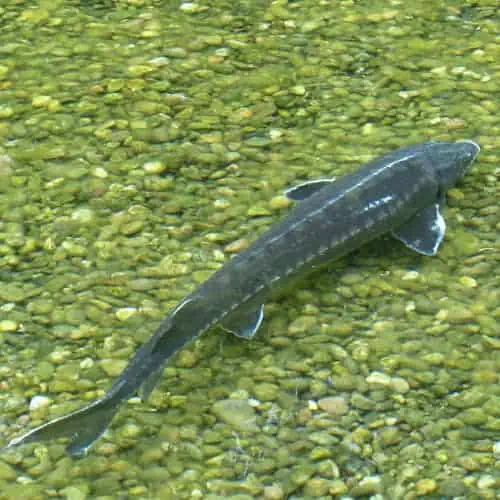
The largest freshwater species in the Great Lakes, the lake sturgeon is a gentle giant that can measure more than 6 feet (1.8 m) long. Seemingly armored and ancient, this species may sometimes be considered a living fossil. Contrary to this perception, it is actually the result of many rapid and subtle evolutionary adaptations as a response to considerable changes in the environment. Once you bear witness to a lake sturgeon, you’ll be hard-pressed to forget its distinct appearance. Its pointed nose, streamlined shape, and distinct rows of bony plates along the length of its back can make it look like a formidable predator. Yet, nothing could be further from the truth!
Lake sturgeons are fully satisfied after a dinner of soft food, which they mostly take up from the lake floor. Due to their lack of teeth, their prey must be small enough to be swallowed whole. This largely limits what they are able to consume. As a result, small fish may occasionally be a part of their diet but are rarely the primary source of nutrients. The longest-lived of all Lake Erie’s fish and increasingly rare due to habitat loss and overfishing, local populations are now protected by federal laws.
10) Coho salmon (Oncorhynchus kisutch)

A highly desirable source of protein, this commercially important salmonid serves as the backbone of several fishery industries along the Pacific coast of North America. It is considered a popular game fish due to its fantastic spurts of energy while chasing after lures in saltwater. Typically anadromous, fully landlocked subpopulations now exist. Commonly referred to as “silvers”, these fish are best hooked where they search for baitfish – mostly along fairly calm stretches of river.
Coho salmon abundances tend to vary throughout the year. In Lake Erie’s tributaries, the peak seasons for fishing them take place in late spring and late summer. Their prey preferences are located throughout the water column and include a wide variety of baitfish and aquatic invertebrates. Due in part to their diverse diets, anglers have had success with various lures. If you’re seeking both tasty game fish and some unforgettable action, this is an ideal species to target!
11) Largemouth bass (Micropterus salmoides)

Though not as popular as its close cousin, the smallmouth bass, the largemouth does get a lot of attention and is considered a prized game fish in Lake Erie. Known for its striking appearance, this fish is a formidable predator with an enormous mouth to match its appetite. It is capable of consuming prey as large as its own head. Large specimens can reportedly consume wildfowl and small mammals! On average, however, it prefers smaller baitfish that frequent highly vegetative nearshore reefs.
As an apex predator, its populations are vital for the control of rapidly reproducing and potentially troublesome fish species. The round goby, an invasive species, has repeatedly been found in stomach samples of largemouth bass. Largemouths can also be regarded as biological indicators of clean lake systems as they are sensitive to mild alterations in freshwater quality.
12) Common carp (Cyprinus carpio)
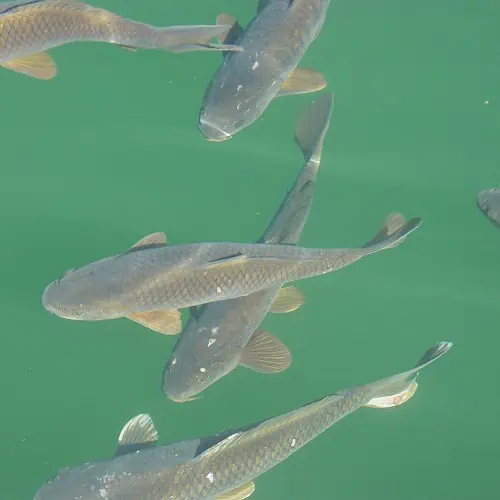
With a knack for thriving pretty much anywhere, it’s no surprise that common carp populations have become quite abundant in the Great Lakes. This invasive species is well-established in Lake Erie, where it most likely benefits from the warmer water and high productivity rates. Situated at the base of the food chain, it can rapidly outcompete native bottom and filter feeders. Despite the abundance of apex predators, regulating carp populations remains to be extremely challenging.
In an effort to restrict the range of common carp populations and prevent them from traveling into other lake systems, some states have opted to artificially close possible connectivity pathways. Dams and electrical barriers are just a couple of means of preventing their spread, though this may adversely affect the populations of some migratory fish. You would be doing a service to the Great Lakes ecosystem by fishing out this nuisance fish!
13) Alewife (Alosa pseudoharengus)
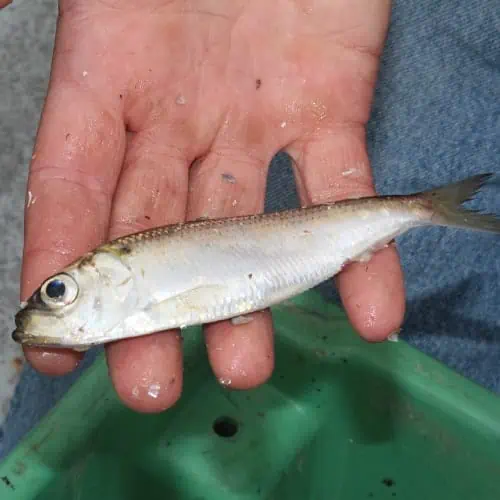
Unfortunately likened to a portly female tavern-keeper, this amusingly named fish is a type of herring with a distinctly large front body. In Canada, it is referred to with less offensive (yet less catchy) common names, such as ‘gasparot’ and ‘kiack’. This species has both anadromous and landlocked subpopulations. Those in lakes may be referred to as ‘mooneye’ or ‘sawbelly’. These are known for having invaded the Great Lakes system through the Welland Canal in Ontario.
In freshwater bodies that lack apex predators, alewife populations can rapidly take hold and cause negative shifts in the food chain. The introduction of salmonids has helped control their populations, leading to the popularization of a salmon/alewife fishery. Despite a fair reduction in their numbers, they remain involved in the decline of many native zooplankton species. Conversely, they are also considered a species of concern as habitat loss has been observed to reduce their spawning rates.
14) Freshwater drum (Aplodinotus grunniens)
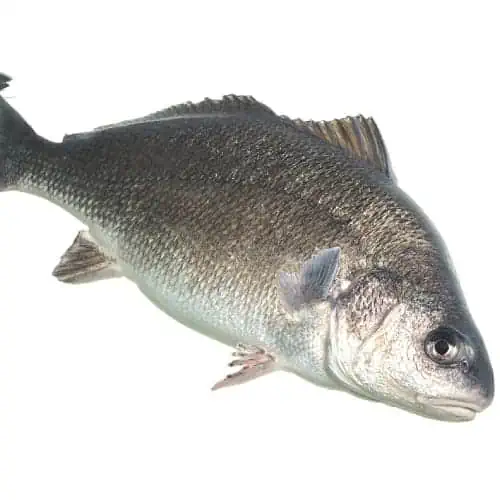
Also known as sheepshead, this full-bodied fish is the sole freshwater species under its family, Sciaenidae. Its species epithet, grunniens, is Latin for “grunting”. Sexually mature males emit a grunting noise, usually while spawning, due to muscles that vibrate alongside the swim bladder. Whether this has a true functional purpose remains to be unknown, but it certainly sets apart males from females. With a preference for clear and fairly shallow water, this fish prefers to spawn during warm months.
Unlike many game fish, the freshwater drum can be caught without restrictions. Despite the limitless daily catch rate and a commercial harvest rate of a million pounds per year, there are yet to be declines in their populations due to overfishing. On average, fairly abundant species can live for up to 13 years and grow to a length of 30 inches (76 cm)! It is a rich protein resource for larger fish, but a less popular option for human consumption. Unfortunately, it is not considered a meaty fish despite its minimal bone content.
15) White bass (Morone chrysops)
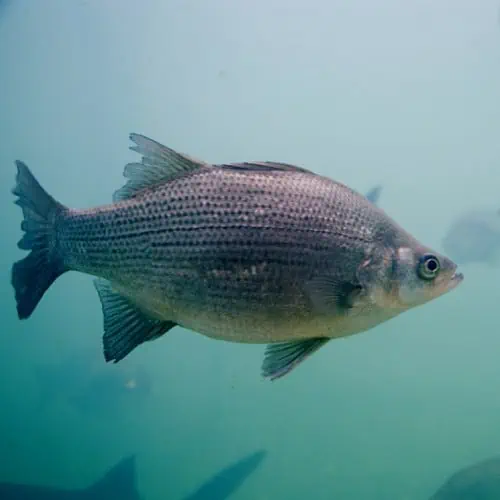
If you’re after white bass in Lake Erie, you would do well to search for them along the mouths of Sandusky, Portage, and Maumee rivers in the western basin. They are quite abundant in these areas and may be found in higher densities upstream. Their deep and compressed bodies are able to reach a maximum length of 17 inches (43 cm) and are distinguished by a silvery-white sheen.
This carnivorous species is a visual feeder and will readily take bait in the form of minnows or live worms. It regularly feeds on several types of small invertebrates, including copepods and water fleas. Larger specimens may feed on smaller fish, though these are less likely to compose a major part of their diet. Lipid accumulation is extremely important through spring and fall so that the bass are able to insulate themselves properly in winter.
16) Gizzard shad (Dorosoma cepedianum)
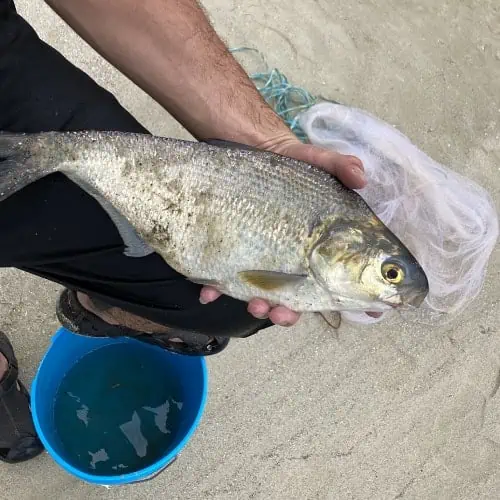
First recorded in Lake Erie’s waters as early as the mid-1800s, gizzard shad calls a wide variety of freshwater bodies home. Though it is a member of the herring family, it is unfavorable as a food fish for human consumption. Moreover, it can seldom be hooked effectively. In fact, it is better used as a baitfish to catch larger, meatier species. As its common name suggests, its digestive system is equipped with a gizzard, aiding in separating plankton from inorganic materials.
In its native regions, gizzard shad can occur quite abundantly. They can grow quickly and spawn profusely, making their populations somewhat resistant to predation. They also have the tendency to compete with other native species. As a result, this species may often be considered a nuisance fish. Moreover, the copious waste production of large populations can lead to algal blooms in some areas by increasing the bioavailability of nutrients.
17) Burbot (Lota lota)
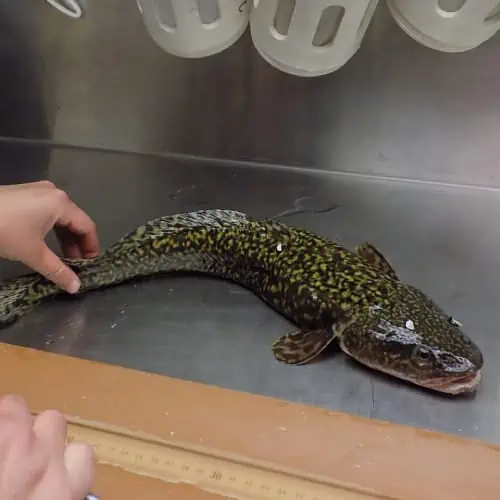
This elusive, eel-like fish spends most of its time on the bottom of Lake Erie. Here, it is able to escape warm temperatures and maintain a secretive lifestyle. Anglers that have hooked a few individuals note that this species is commonly found in the eastern basin of the lake, which is the southernmost point of its distribution in the US.
The best time to catch this cold-water species is during the peak of winter, and in the middle of the night. Fishing them can be challenging for those without much experience. Though listed as a species of concern in Ohio, burbot can still be legally captured by anglers. Researchers have had difficulty gauging the extent of their populations, but they surmise that the booming populations of parasitic sea lampreys may have compromised their spread in the Great Lakes.
18) Sea lamprey (Petromyzon marinus)

An invasive species, the sea lamprey is implicated in significant declines in game fish populations throughout the Great Lakes. Fittingly called “vampire fish”, this living fossil has thrived for centuries by sucking the blood of just about any fish it can come across. It uses its sucker-like mouth, which is covered in concentric rows of sharp teeth. To prevent the blood of its victims from clotting, it orally emits a fluid called lamphredin.
Sea lampreys supposedly spread in Lake Erie due to the alteration of the Welland Canal. Once their populations became established in the lake, they ventured to other areas through streams and tributaries. They have wrought considerable damage wherever they’ve gone, resulting in the need for radical elimination strategies. Physical barriers, electric currents, and chemical lampricides have all been used and have had varying levels of effectiveness.
19) Emerald shiner (Notropis atherinoides)

Named for the emerald sheen of its lateral scales, this slender fish is a type of minnow that grows to just 3.5 inches (9 cm). It is often cultivated as an aquarium fish due to its attractive metallic coloration. The emerald shiner is fairly common throughout the Great Lakes region, where it is often captured in traps and used to bait larger game fish. In Lake Erie, it typically occurs in the midwater layer of the water column. Like many small fish, it prefers to forage and navigate through the lake in schools.
Emerald shiners feed on pelagic food types. Zooplankton and aquatic insects make up a large portion of their diet, with algae occasionally making an appearance in their guts. They reach sexual maturity after just 2 years of growth, after which they spawn in early to mid-summer. Daily catch limits for this species are quite generous, though there are regulations against using several types of nets.
20) Rainbow smelt (Osmerus mordax)

Known for its iridescent coloration, this slender fish was intentionally introduced into the Great Lakes in the early 1900s. Typically anadromous, those that occur in enclosed freshwater bodies are fully landlocked populations. They are seldom able to migrate over long distances to spawn as they are weak swimmers. Dams are a significant barrier for them despite the presence of fish ladders.
Rainbow smelt typically reach a length of 7 – 9 inches (18 – 23 cm) at maturity. They seldom weigh over 100 grams, as their bodies are remarkably slim and cylindrical. Juveniles are zooplanktivorous, favoring water fleas and copepods. They are often found close to shorelines, in warm, shallow water. Larger adults have notably canine-like teeth, which aid them in consuming small crustaceans, fish, and larvae. These are more abundant in cooler, pelagic zones of the lake.
21) Longnose gar (Lepisosteus osseus)
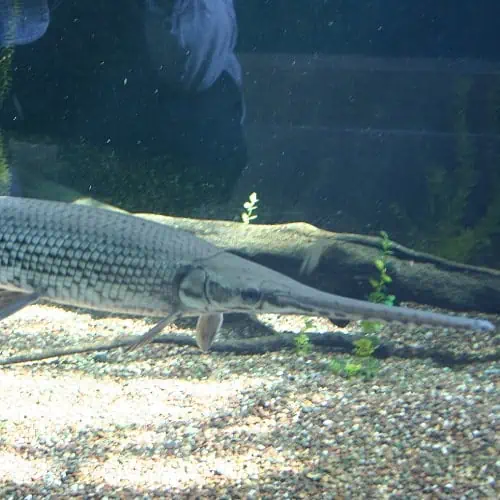
Easily identifiable due to its primitive features, the longnose gar has a fossil history that can be dated back to millions of years ago. This strange-looking fish is bony and seemingly covered in body armor. Its streamlined body resembles a torpedo, with jaws that are remarkably long relative to its full length. Capable of breathing in water or air, it is able to tolerate low-oxygen bodies of freshwater, such as swamps and backwaters.
Sometimes likened to gators, gars are nocturnal feeders that prey on a wide variety of baitfish and smaller game fish. The species that make up significant portions of their diet differ based on location, availability, and water properties. Interestingly, longnose gars can tolerate high water salinities (up to 31 ppt). They prefer to remain in structurally rich microhabitats, such as submerged stony outcrops and vegetative shorelines with drowned logs and trees.
22) Bigmouth buffalo (Ictiobus cyprinellus)
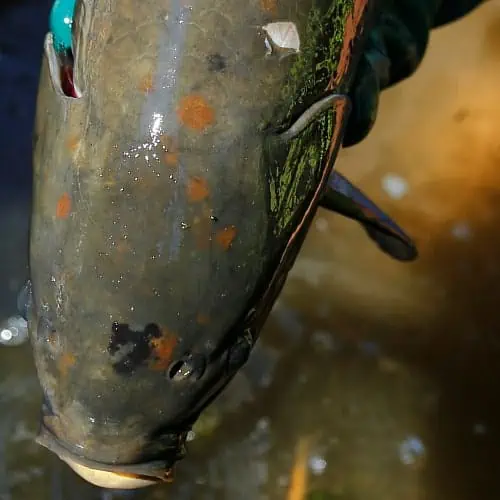
The bigmouth buffalo is an enormous sucker that is known for being one of the most long-lived freshwater species. An individual can persist for more than 100 years, yet reproduces sparingly. As a result, its populations are highly vulnerable to environmental degradation and are currently in decline. It is a fairly elusive species as researchers have yet to shed light on its habitat preferences and the extent of its distribution in Lake Erie.
Intentionally stocked in the Erie Basin in the early 1900s, a commercial fishery for buffalo fish eventually took off. Hybrids of this species and its closest relatives began to occur more frequently. Unfortunately, this species is now considered quite rare. There is much that remains to be known about bigmouth buffalo, but one thing’s for sure – anglers that are lucky enough to catch sight of one will forever have a unique story to tell!


I didn’t know we had this many fish in our lake.
Amazing article! 10/10! Thank you for sharing your fish with me.
what about crappies and bluegill families i have caught both misery bay. never caught but any catfish species. also endangered blue pike has been caught recently
Thank you! I enjoy fishing out on Lake Erie so this helps me know what I’m looking for!
Thank You 4 Sharing